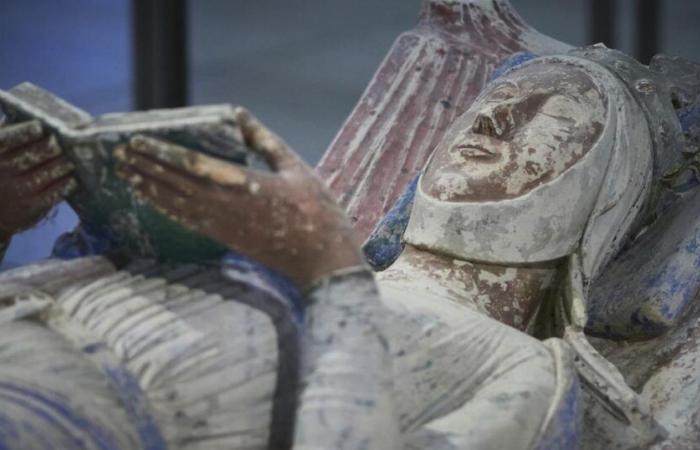
Around the queen’s recumbent figure, you can discover a reconstruction of the Plantagenets’ funeral chapel designed in the 17th century.
Queen of France and then Queen of England, Eleanor of Aquitaine celebrates her 900th birthday at the royal abbey of Fontevraud (Maine-et-Loire). A completely new decor, inspired by rich 17th century furnituree century dispersed during the Revolution, was rehabilitated to accompany the medieval recumbent statue of this queen, jewel of the abbey church.
Baptized From one world to another, Aliénor’s final resting place in Fontevraudthis exhibition scheduled until March commemorates the nine centuries since the birth of Eleanor, a powerful woman with an exceptional destiny, born in 1124 (or 1122 depending on the source) and died in 1204.
The solid wood scenography brings back to life the ornamental setting commissioned by a 17th century abbess to majestically surround the polychrome recumbent figures of Eleanor, her second husband, King Henry II Plantagenet of England (1133-1189) and their son Richard the Lionheart (1157-1199).
“What we have recreated in situ is the cemetery of the kings: it is the funeral chapel of the Plantagenets, notably of Eleanor of Aquitaine and Richard the Lionheart, which was fitted out in the 17th century by the abbess Jeanne-Baptiste de Bourbon, natural daughter of Henry IV.”Nicolas Dupont, curator of the abbey, explained to AFP.
Only one partial engraving remained
This reconstruction is the result of an investigation carried out by a heritage curator, Florian Stalder, who rediscovered in churches near Fontevraud certain pieces, such as altarpieces and panels, probably coming from this 17th century decor.e century and dispersed during the Revolution.
“It’s not the same”Nicolas Dupont specifies, however, because only a partial engraving from the period gives an idea of the decor built by Jeanne-Baptiste de Bourbon (1608-1670). “It’s both a scenographic project, almost artistic, and also mixing originals. It’s a kind of reconstruction.” in real size, he argues. Pyrography illustrations on large wooden panels depict the intertwined destinies of Aliénor and Jeanne-Baptiste.
“Building funeral monuments is to establish their image”notes Nicolas Dupont. “Eleanor wants to create a dynastic necropolis (of the Plantagenets, editor’s note) like that of the Capetians in Saint-Denis. And Jeanne-Baptiste inaugurates this cemetery of kings two years after becoming abbess, and she takes advantage of it to hold her enthronement ceremony.”
The Royal Abbey of Fontevraud, a UNESCO World Heritage Site, is presented as the largest monastic city inherited from the Middle Ages in Europe. Built from the 12th century, the abbey was transformed into a prison after the Revolution, a role it retained until 1963.





